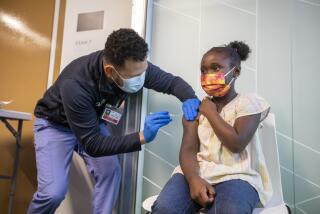Opinion: An important word is missing from Trump’s ‘Opening America’ guidelines: Quarantine
- Share via
The Trump administration’s guidelines for “Opening Up America Again” try to chart a path out of our coronavirus bunkers, but there’s a key piece missing: A strategy to defeat the virus after we stop sheltering in place.
The countries around the world that have been most successful in limiting infection and death have not only tested people for COVID-19 at a far greater rate than the United States, they’ve been much more hard-nosed about separating people who’ve been exposed to the virus from the rest of the population — enabling the immune systems of infected people to destroy it before it spreads. That kind of virus-trapping strategy requires the ability to track down everyone who’s come in direct contact with people who test positive for COVID-19 and then quarantining those individuals.
The word “quarantine” does not appear anywhere in the administration’s guidelines. Instead, they talk about isolating people who are “vulnerable” to the disease — individuals who are elderly or have high blood pressure, asthma, a compromised immune system or other “serious underlying health conditions” — as if it makes sense to let the virus spread freely through the rest of the population.
The U.K. tried that, thinking the virus could be defeated by developing a form of herd immunity in the general population. That didn’t work out so well. On the plus side, at least the prime minister is no longer hospitalized.
The main U.S. strategy to defeat the disease has been to accelerate the development of a vaccine and the testing of potential treatments. Although the global efforts on this front are epic, the tests being conducted aren’t expected to yield meaningful results for several months (or in the case of a vaccine, more than a year).
In rural and hard-to-reach areas, postal workers are the only ones who provide regular delivery service.
Other than that, all we’ve really done here is hide from the disease, observed Dr. Thomas Frieden, former director of the Centers for Disease Control and Prevention. That’s what social distancing is: a community-wide game of keep away from the virus. And if we stop playing before the virus is eradicated, we will be just as vulnerable as we were before we started.
Granted, the stay-at-home orders are causing a lot of harm too, and President Trump is right to try to develop a strategy for easing our way out of those orders. But that strategy needs to involve more than just carefully returning to workplaces while maintaining social distancing, as the administration’s guidelines suggest for areas where reported infections or suspected infections have decreased for 14 days. States and local governments must try to actually defeat the disease by seeking to find and isolate the people who’ve come in contact with the virus.
Frieden laid out one such strategy in a briefing Friday morning, calling for a four-pronged effort to box in the coronavirus through stepped-up testing, contact tracing, isolating infected people and quarantining anyone found to have been exposed. Doing this at the required scale will be a massive and costly undertaking, requiring tests to be conducted at three to 20 times the current rate of around 150,000 per day; a huge deployment of trained contact tracers (Frieden said China had one per every 1,000 residents in Wuhan, which would translate to 39,000 just in California); and the provision of safe isolation and quarantine spaces for infected and exposed people, respectively, who cannot remain in their homes (for example, if they live with elderly relatives). Isolated and quarantined people may also need meals and financial support.
One other caveat from Frieden: Having the number of new infections and deaths on a sustained downward slope is certainly a prerequisite, but the total number of cases matters too. Until the rate of new cases per day drops to around 40 per 1 million people, it won’t be feasible to trace all the contacts of each new infected person. And the more we move away from sheltering in place, the more people each newly discovered infected person will have exposed, adding to the contract-tracing challenge.
The task is daunting, yet we have the resources in this country to do it. We just have to have the political will to actively fight the disease, rather than just coming out of hiding and hoping for the best.
More to Read
A cure for the common opinion
Get thought-provoking perspectives with our weekly newsletter.
You may occasionally receive promotional content from the Los Angeles Times.











